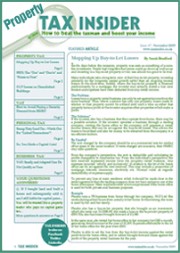Before you go, sign up to our free tax saving email course. Get 7 top property tax saving strategies in your email inbox that will help you save thousands in tax. Unsubscribe any time.
 In this final instalment of a three-article series on business structures, we look at a comparative newcomer – the Limited Liability Partnership, or LLP. In this final instalment of a three-article series on business structures, we look at a comparative newcomer – the Limited Liability Partnership, or LLP.
For many years it was possible for a partner in a partnership to enjoy ’limited liability‘ – that is, the assurance that if the business became insolvent, its creditors could not go after his private assets such as his house – but this was only possible for a ’sleeping partner‘ – one who took no part in running the partnership business.
The Limited Liability Partnership Act in 2000 introduced a new type of business entity, the LLP. Members of an LLP have the same limited liability as shareholders of a limited company, but they are taxed on the LLP’s profits and gains in the same way as partners in a partnership. For as long as it is carrying on any kind of business - including a property letting business - an LLP is ’transparent‘ for tax purposes, with its members being charged to income tax or capital gains tax on the profits or gains of the LLP according to their share of them – and that share is a matter for the members to agree for each year.
Because the members of an LLP are protected from the business creditors by ’limited liability‘ as described above, an LLP is required to file its accounts each year at Companies House, and these can be accessed by any member of the public on payment of a small fee. Some business owners dislike the public availability of this information, not only because it enables competitors (and customers) to get at least some idea of their business results, but because it can affect their rating with the credit agencies that are becoming such a powerful force not only in business but in government – witness the recent problems with the credit ratings of some of the EU member’s government bonds. Assuming the business is sufficiently solvent and successful not to worry about its credit rating, an LLP offers a secure and flexible way to structure a business, and when it is combined with a limited company, some significant tax advantages.
In the previous month’s article we saw how a company pays a lower rate of tax on its profits than an individual or a partner in a partnership, but that the tax cost of extracting cash from the company can mean that the shareholders end up paying more tax than if they had simply formed a partnership.
LLPs and Company Members
One of the major strategic problems for a traditional partnership (or an LLP without a corporate member) is the maintenance of its working capital, because the partners (or LLP members) will have to pay tax on their share of the profits whether they take them out of the business bank account or not, so there is always pressure not only to allocate the profits but to draw them as well. With a limited company as a member of the LLP, profits can be earmarked for future capital investment and allocated to the limited company member, where they suffer a lower rate of taxation and remain available to the business to fund growth.
Practical Tip
This is a sample article from the monthly Property Tax Insider magazine. Go here to get your first free issue of Property Tax Insider. |


 Tax Articles
Tax Articles